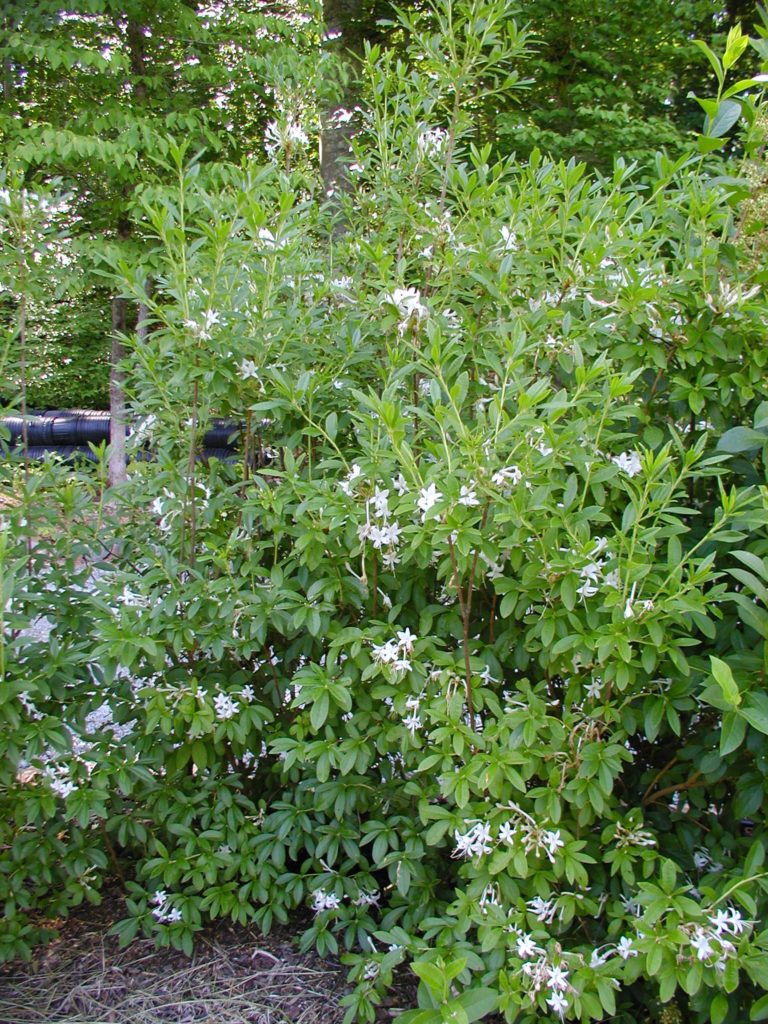Swamp Azalea is a shrub up to 8 ft tall at maturity with an upright, loosely branched, multi-stemmed habit and a tantalizing, musky floral scent in late spring. Clusters of very fragrant bright white (often with pink accents), trumpet-shaped flowers with five petals, slender tubes and elegant, exserted stamens appear in late May and persisting into July, after the dark, shiny foliage has emerged. Attracting all kinds of pollinators and offering habitat to birds, Swamp Azalea is the last of the spring-blooming native azaleas, followed then by R. Serrulatum (which is actually closely related) and R. prunifolium (Plum Leaf Azalea). Native to swampy areas in the coastal plain, it does tolerate somewhat wet conditions, but not standing water — it prefers moist, well drained, acidic soils, in full sun (if sufficiently moist) to filtered shade. In the autumn, the foliage can develop excellent fall color. Swamp Azalea ranges from the southernmost tip of Maine down and around to East Texas, preferring “damp ditches, swamp margins, sandy fields and dry ridges”. Beautiful, tough, aromatic and adaptable! What’s not to like about this shrub!
NURSERY HOURS
Wednesday: 10-4 Thursday: 10-6 Friday-Saturday: 10-4 Sunday: 12-4
Rhododendron viscosum

Key Info
Scientific Name: Rhododendron viscosum (L.) Torr.
Common Names: Swamp Azalea, Clammy Azalea, Honeysuckle Azalea, Swamp Honeysucle, Hammock Sweet Azalea, Cory Azalea
Family Names: Ericaceae (Heath Family)
Plant Type: Tree / Shrub
Leaf Retention: Deciduous
Flower Color: White
Special Characteristics: Attracts birds, Tolerates wet conditions, Rhizomatous, Attracts bees, Attracts butterflies, Flowers fragrant, Attracts Hummingbirds, Good fall color
Additional Info
Habit: Thicket-forming, spreading shrub with a loose, open habit.
Height: 2' - 8'
Spread: 8'
Soil Conditions: Medium moist to wet, acidic, well drained, organically rich soil, sandy, loamy, clay.
Leaves: Alternate, simple, oval-shaped leaves 1½ to 3 inches long x ½ to 1½ inches wide, with short-pointed tips, are clustered at the ends of the stems. Leaves are lustrous dark green above and pale green below, turning attractive shades of yellow, orange and purple in fall.
Flowers (or reproductive structures: Perfect, white, sometimes pinkish white, tubular flowers up to 1 3⁄4 inches long by 1¼ inches across with a sweet, clove-like aroma, bloom in clusters of 4-9 after the leaves have emerged, in May-July. The flowers are sticky, "viscosum" referring to a viscous substance excreted by glandular hairs on the corolla tubes of the flowers. The 5 stamens extend gracefully well beyond the corolla.
Fruit: Many seeds in small, egg-shaped, brown capsules up to 3/4" long, mature in fall.
Natural Distribution: Swamps, bogs on coastal plain; stream margins, moist woods in mountains.
USDA Hardiness Zone: 4 to 9
USDA Wetland Indicator Status in NC: FACW (mtns); OBL (on coastal plain)
Pollination: Hummingbirds, long-tongue bees, butterflies, other insects.
Wildlife Connections: Thick foliage provides habitat for birds; flowers attract large numbers of bumble bees, hummers, butterflies. Is not immune to deer browse.
Propagation: Propagated by seed.
